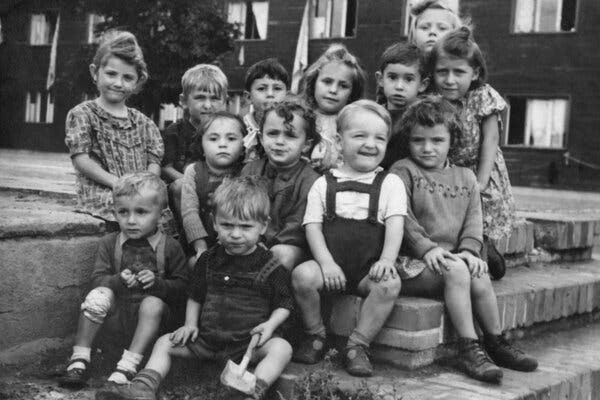Even with New York’s complicated history as a port for new arrivals, the photographs this summer of more than a hundred migrants sleeping shoulder to shoulder on the sidewalk outside the once-elegant Roosevelt Hotel in Midtown Manhattan were shocking. So were scenes of young migrants idling on sidewalks, stoops and park benches, desperate to work but legally prohibited from doing so.
For those of us who were once part of such a moment, the scenes stirred up memories and reflections on how different some things were now for new arrivals and how much they were the same. I, too, was once part of a migrant influx.
In the years after the end of World War II, New York City absorbed a similar wave of immigrants — a large majority of the 140,000 Jewish Holocaust survivors who came to America between 1946 and 1953 — and it did so comparatively smoothly and uneventfully. These immigrants were eager to get on with their lives but were still in shock or heartbroken from the brutalities they had suffered, the parents and siblings they had lost, and the hometowns they could no longer return to.
Those who had no relatives to stay with were put up in 14 hotels that had seen better days as well as in a shelter hacked out of the former Astor Library on Lafayette Street, which is now the Public Theater.
My family was among those immigrants, having spent the previous four years waiting for visas to the United States while idling in two camps for so-called displaced persons in the American zone in occupied Germany. After a rocky voyage on a merchant marine vessel called the U.S.S. General A.W. Greely, my parents, my brother and I arrived on March 3, 1950, at a pier on West 21st Street. My brother Josh was not yet 3. I was 5.
Since it was the festive holiday of Purim, the Hebrew Immigrant Aid Society greeted us with hamantaschen and coffee. And then our valises and duffel bags were piled into a van and we were taken to Capitol Hall on West 87th Street off Amsterdam Avenue.
Unlike the more than 130,000 migrants who have arrived in New York since the spring of 2022, we immigrated in comparatively programmed fashion. Our entry was sanctioned by a 1950 amendment to the 1948 Displaced Persons Act intended to admit tens of thousands of concentration camp survivors and other people whose homes and villages had been destroyed by the Nazi extermination campaign or who feared retribution from the Soviet authorities for opposing communist governments in Eastern Europe.

The fact that we were admitted into the United States did not mean that we entered in entirely kosher fashion. It was somewhat problematic that my parents had survived the war in the Soviet Union, my father as a Polish draftee into the Soviet army, my mother by slipping out of the Nazi occupation of Warsaw. They met in a factory town in the Ural Mountains, where they married and where I was born in January 1945. After the war, they and a brother of my mother’s were the sole survivors of what had been two large families. Their hometowns’ Jewish communities had been almost completely wiped out.
Like many Jews, they considered migrating to the new nation of Israel, but my father worried about another outbreak of fighting there and chose to wait for America to open its doors to the refugees. Because of the burgeoning fever of anti-communism that would culminate with the McCarthy era, my parents feared that if they declared their true whereabouts during the war they would be denied entry. So, like tens of thousands of others who had found refuge from the Nazis in the miserable depths of the Soviet Union, they destroyed any authentic documents and made up tales of survival. They told the American authorities — and us, their children — that they had spent the war years hiding in Poland. They did not reveal the true story to me until I was in my early 20s and realized that aspects of their original story did not jibe.
Capitol Hall, our first American foothold, was hardly a big improvement over the displaced person camps. The single room we were given was dingy and dusty, and my brother and I had to sleep on tightly stretched canvas cots. But it was a roof over our heads and had the advantage of being close to the bustle of Upper Broadway, where many refugees, some utterly alone in America, would take walks to search for faces they might recognize from their hometowns or the concentration or refugee camps.
My mother was enchanted by the lively cosmopolitan spirit of the Upper West Side, a neighborhood with bookstores and a movie theater, the Thalia, that was showing foreign films like “The Bicycle Thief.” For her, the neighborhood had the cultural exuberance of prewar Warsaw. Many of the hotels along Upper Broadway — the Marseilles, the Whitehall, the Midway and others — had reserved most of their rooms for refugee clients of the Hebrew aid society and other Jewish agencies.
The largest of these was the 271-room Marseilles. My first friend in America, Simon Herling, and his parents were housed there for several weeks before they found a one-room apartment on a shabby block off the northern edge of Central Park West. One of the few children born in a concentration camp, he was 3 years old when he arrived in New York in 1948 and remembers nothing of the Marseilles. But my own memories and contemporary newspaper accounts suggest that the lobby’s hurly-burly was reminiscent of Rick’s Café in the film “Casablanca,” with refugees desperate for information on where to live and work, obtain necessary documents, receive subsistence stipends or connect with relatives. One might have expected Peter Lorre to show up with “letters of transit.”
In the few weeks we resided at Capitol Hall, we visited a friend of my father’s at the aid society’s shelter on Lafayette Street, a Romanesque Revival building dating to 1853 that the aid society purchased in 1920. A second-floor balcony had been divided into cubicles, and each refugee family was housed in a cubicle’s cramped confines.
Jane L. Wechsler, a Manhattan artist whose parents came from Polish shtetls and survived the war as refugees in what is now Uzbekistan, remembers spending a night at the shelter as a 3-year-old in 1951 and then being put up for a few weeks at the Prince George Hotel on East 28th Street, a Beaux-Arts building that was once among New York’s grandest but had fallen into disrepair.
She recalls feeling like an outsider, different from other children because her parents didn’t speak English, she had no grandparents and she knew her parents “had lived through a catastrophe though as a child I didn’t understand the details and the enormity.”
Of her stay at the Prince George, she remembers “looking out the window and seeing a worker in an opposing building looking back with a ‘how adorable’ expression and then my running away and hiding under a table.”
Of the 313,991 displaced persons who arrived in the United States between June 1948 and December 1951, nearly 20 percent were helped in some way by Jewish agencies. To ease our transition to becoming citizens, the Hebrew aid society and like-minded groups not only provided beds but also guided the recent arrivals through the bureaucracy of becoming New Yorkers.
The society’s women’s division conducted classes in basic English and published a booklet in Yiddish to help the refugees for their eventual citizenship tests. Another nonprofit, the New York Association for New Americans, offered job placements and training. The American Jewish Joint Distribution Committee provided assistance to ease the journey from Europe.
As William B. Helmreich’s 1992 study of U.S. Holocaust survivors makes clear, most of them soon became productive American citizens and their children flourished or floundered at the same rates as other Jewish Americans.
Bare bones as these refugee services were, they were almost luxurious compared with what today’s migrants are receiving. Recently, I spoke to some of the residents at a former 59-room Best Western in the Midwood section of Brooklyn. Franyori, 29, who asked that her last name not be used fearing trouble with immigration authorities, fled her hometown in the state of Carabobo in Venezuela with her three children because the local police were harassing and extorting her husband and he feared for his life.
“The insecurity and violence is too high,” she said, speaking through a Spanish interpreter. “If the police see someone who has value, they extort them. There’s no place to complain other than the police department, and they cover each other.”
After her husband made his way to New York, she and her children followed, paying a guide to take her through the treacherous Darién Gap connecting Colombia with Panama. Along the grueling hike, she jettisoned food, clothing and possessions to lessen the load. By requesting asylum, she was allowed to enter El Paso from Ciudad Juárez, Mexico. In April she and her children flew to New York.
At the former Best Western, she is given daily packages of frozen food that need defrosting, but, she said, there are only two microwaves for the entire building. She is not allowed to have an electric hot plate or a rice cooker. The three children — a 13-year-old girl and two boys, 9 and 3 — share a queen-size bed.
“There is no social worker in the building to tell me where to find a school, where to find a job, where to find documents,” she said. “I have to find out in the street.”
Her story had resonances of my family’s early years. After a few months of receiving aid and advice from the immigration agencies, we were on our own, and my parents often had to make decisions with insufficient or mistaken information. Because I was learning English in school, they sometimes relied on me for translating documents and notes home from school, and I can remember feeling not quite up to the job.
Juan Carlos Basque Gomez, an Ecuadorean asylum seeker living at the former Best Western, said his most urgent need is obtaining a permit that allows him to work. He can cadge occasional jobs in construction and painting through tips from fellow workers, but without a permit he has been unable to nail anything more permanent.
Under an immigration law passed in 1996, asylum seekers must wait 180 days before even applying for a work permit. In practice, the law has forced immigrants to scrounge for off-the-books jobs as food delivery workers or restaurant dishwashers or else live off meager government and charitable assistance. In late September, the Biden administration allowed Venezuelans who were on American soil before July 31 to work. But the order granting temporary protected status did not apply to immigrants packing the city’s shelters from other countries.
No such law was in effect during the influx of Holocaust refugees. Ms. Wechsler’s father was an expert metal craftsman and quickly secured a job shaping heating ducts for school buildings. Simon Herling’s father, who survived a Buchenwald satellite camp by providing skillful haircuts for the German officers, found a barber’s job in Midtown Manhattan just days after his arrival.
And within months of landing in New York, my father, with a Polish elementary school education and few valuable skills, was able to find a job. A neighbor in our first apartment after the hotel stay took my father along to the factory in New Jersey where he worked making covers for ironing boards. And so began a blue-collar career that lasted 25 years, most of which was spent serving as the plant’s foreman. It was not prestigious, but my father — helped by my mother’s paycheck from a Manhattan hat factory — was able to put food on the table for his family.
Mr. Gomez, here with his wife and infant son, still relies on meals provided by the city supplemented by occasional visits from nonprofits like Masbia Relief, an affiliate of a Brooklyn-based kosher soup kitchen and food bank, and Brooklyn Emerge, a halal-observant food pantry. That dependence, his joblessness and such indignities as a 9 p.m. curfew at the former Best Western enfeeble him, he suggested.
“I feel like I’m in prison,” he said.
This post was originally published on this site be sure to check out more of their content.







